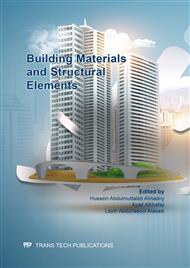[1]
Strategic Highway Research Program (SHRP), Summary Report on Permanent Deformation in Asphalt Concrete. SHRP-A/IR-91-104. Institute of Transportation Studies University of California Berkeley, California, (1991).
Google Scholar
[2]
K. E. Kaloush, K. E. and M.W. Witzack, Simple performance tests for permanent deformation of asphalt mixtures. Paper presented at the 2002 annual Transportation Research Board meeting (2002).
Google Scholar
[3]
US Federal Highway Administration. Validation of asphalt binder and mixture tests that measure rutting. FHWA-RD-99-204 (2000).
Google Scholar
[4]
AASHTO, Standard Method of Test for Determining the Rheological Properties of Asphalt Binder Using a Dynamic Shear Rheometer (DSR), AASHTO T 315-06 (2006).
DOI: 10.1520/d7175-15
Google Scholar
[5]
G. H. Shafabakhsh, M. Sadeghnejad, and Y. Sajed, Case study of rutting performance of HMA modified with waste rubber powder. Case Studies in Construction Materials, 1, (2014) 69–76.
DOI: 10.1016/j.cscm.2014.04.005
Google Scholar
[6]
H. Ziari, R. Babagoli, and A. Akbari, Investigation of fatigue and rutting performance of hot mix asphalt mixtures prepared by bentonite-modified bitumen. Road Materials and Pavement Design, 16(1), (2015) 101–118.
DOI: 10.1080/14680629.2014.982156
Google Scholar
[7]
R. Ghabchi, D. Singh, and M. Zaman, Laboratory evaluation of stiffness, low-temperature cracking, rutting, moisture damage, and fatigue performance of WMA mix. Road Materials and Pavement Design, 16(2), (2015)334–357.
DOI: 10.1080/14680629.2014.1000943
Google Scholar
[8]
M. I. Souliman, M. Piratheepan, E. Y. Hajj, P. E. Sebaaly, and W. Sequeira, Impact of lime on the mechanical and mechanistic performance of hot mixed asphalt mixtures. Road Materials and Pavement Design, 16(2), (2015) 421–444.
DOI: 10.1080/14680629.2015.1017520
Google Scholar
[9]
S. Hussan, M. A. Kamal, I. Hafeez, N. Ahmad, S. Khanzada, and S. Ahmed, Modelling asphalt pavement analyzer rut depth using different statistical techniques. Road Materials and Pavement Design, 21(1) (2020) 117-142.
DOI: 10.1080/14680629.2018.1481880
Google Scholar
[10]
H. Wang, Q. Zhang, and J. Tan, Investigation of layer contributions to asphalt pavement rutting. Journal of Materials in Civil Engineering, 21 (2009) 181–185.
DOI: 10.1061/(asce)0899-1561(2009)21:4(181)
Google Scholar
[11]
Y. Seo, O. El-Haggan, M. King, J. Lee, and Y. R. Kim, Air void models for the dynamic modulus, fatigue cracking, and rutting of asphalt concrete. Journal of Materials in Civil Engineering, 19(10) (2007) 874–883.
DOI: 10.1061/(asce)0899-1561(2007)19:10(874)
Google Scholar
[12]
S. Nikhil, and P. Kumar, Analysis of Different Test Methods for Quantifying Rutting Susceptibility of Asphalt Binders. Journals of Materials in Civil Engineering, American Society of Civil Engineers (ASCE) (2016).
DOI: 10.1061/(asce)mt.1943-5533.0001553
Google Scholar
[13]
D. A. Anderson, and T. W. Kennedy, Development of SHRP binder specification (with discussion). Journal of the Association of Asphalt Paving Technologists, 62 (1993).
Google Scholar
[14]
H.U. Bahia, and D.A. Anderson, The New Proposed Rheological Properties of Asphalt Binders: Why are They Required and How Do They Compare To The Conventional Properties, Physical Properties of Asphalt Binders, ASTM, STP 1241(1995).
DOI: 10.1520/stp18186s
Google Scholar
[15]
L. Tashman, Microstructure viscoplastic continuum model for permanent deformation in asphalt pavements. Ph.D. Dissertation, Texas A&M University, College Station, TX, (2003).
Google Scholar
[16]
R.B. McGennis, D.A. Anderseon, T. W. Kennedy, and M. Solaimanian, Introduction to Superpave Asphalt Mixture Design, Federal Highway Administration, Office of Technology Applications, Washington, DC (1994).
Google Scholar
[17]
Asphalt Institute, Performance Graded Asphalt Binder Specification, and Testing. Manual Series No.1, (SP-1), Asphalt Astiute, Lexington, Kentucky (2003).
Google Scholar
[18]
R. A. Tarefder, and A. M. Zaman, Evaluation of moisture damage in polymer-modified asphalts. Journal of Materials in Civil Engineering, Vol. 22(7) (2010) 714–725.
DOI: 10.1061/(asce)mt.1943-5533.0000072
Google Scholar
[19]
AASHTO, Standard Specifications for Transportation Materials and Methods of Sampling and Testing. 5th edition, American Association of State Highway and Transportation Officials, Washington, D.C., USA (2010).
Google Scholar
[20]
State Cooperative of Roads and Bridges –SCRB, Standard Specifications for Roads and Bridges. The Republic of Iraq, Ministry of Housing and Construction, Department of Design and Studies, Baghdad, Addendum No.3 (2003).
Google Scholar
[21]
AASHTO M320, Standard Specification for Performance –Graded Asphalt Binder. American Association of State Highway and Transportation Officials, Washington, D.C., USA (2014).
Google Scholar
[22]
AASHTO, M 323 Superpave Volumetric Mix Design. The American Association of State Highway and Transportation Officials, Washington, D.C. (2012).
Google Scholar
[23]
European Standard, Bituminous Mixtures-Test methods for hot mix asphalt. EN 12697-22, part-2, Wheel Tracking (2003).
DOI: 10.3403/02964412
Google Scholar


